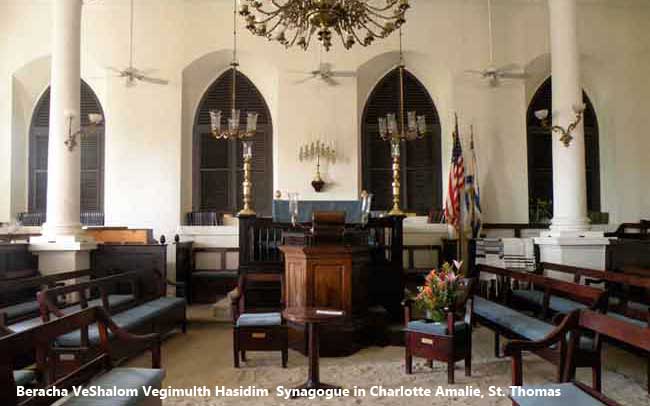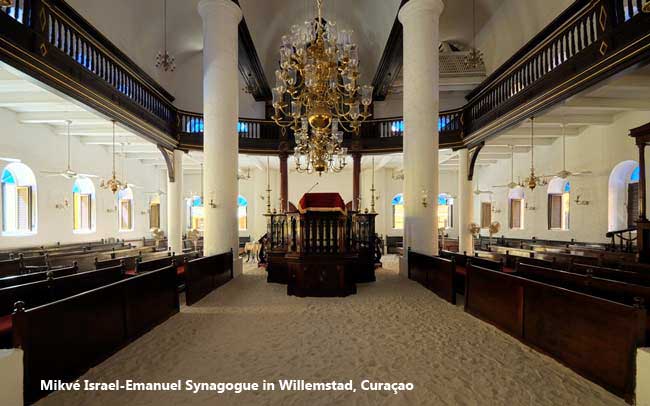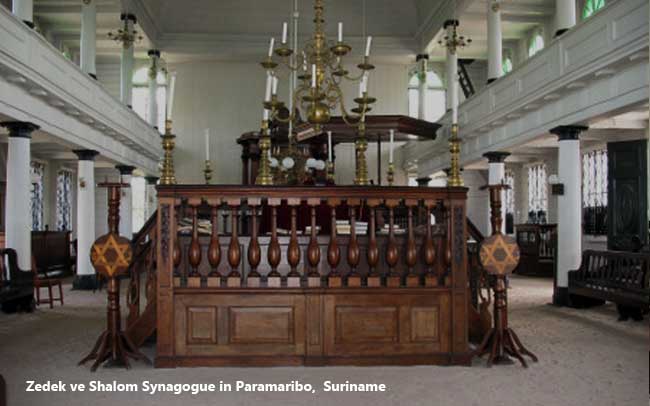Synagogues are a vital part of Jewish heritage and some of them are magnificent historical landmarks. A special feature of some synagogues is that they use sand-covered floors. There are five such synagogues in the world. All five belong to Sephardic congregations.
Four are located in the Caribbean:
- Mikvé Israel-Emanuel Synagogue (‘Snoa’) in Willemstad, Curaçao;
- Shaare Shalom Synagogue in Kingston, Jamaica;
- Beracha VeShalom Vegimulth Hasidim Synagogue in Charlotte Amalie, St. Thomas, US Virgin Islands;
- Zedek ve Shalom Synagogue in Paramaribo, Suriname.
The fifth synagogue with a sand-covered floor is the Portuguese Synagogue (‘Esnoga’) in Amsterdam, the Netherlands.
Several explanations exist for the purpose of the sand.
The Wikipedia page on the St. Thomas Synagogue states: “There are two theories behind this unusual occurrence. One is to represent the Israelite journey through the desert. Another theory is that it represents the conversos who were forced to convert to Catholicism. Many continued to observe Judaism, so they usually met in their cellars and would use sand to muffle their prayers.” [1]
However, in an article in The Toronto Star, Diane Becker Krasnick, the cantorial soloist of the St. Thomas Synagogue, dismisses the first, desert-based theory: “It sounds very plausible. However, there are Sephardic synagogues all over the world without sand floors. There are only four sand floors in the world, all here in the Caribbean because they are all connected with the Jews who escaped the Spanish Inquisition.” She insists that the conversos argument is the only correct explanation. [2]
Mordechay Arbell, who has served the state of Israel in posts as Consul in Colombia and as Ambassador to Panama and Haiti, supports the desert-based argument but gives a slightly different twist to it: “Caribbean Jews explain the meaning of the sand saying that as long as they are not back in Jerusalem, they are still trodding in the desert.” [3]
The conversos argument seems to be the most prevalent argument. Dr. Aviva Ben-Ur of the University of Massachusetts at Amherst, reflecting upon her journey to Jewish Curaçao, also supports this argument: “Those sand-covered floors leave you with a sense of all the silent history contained within its walls. Most of the forebears of today’s Sephardic congregants were secret Jews or marranos from Spain and Portugal who fled the terrors of the Inquisition established in the 15th century. The floors of sand serve to remind the congregation of how its Jewish ancestors on the Iberian peninsula covered the floors of their makeshift prayer houses so that their footsteps would be muffled and the suspicion of potential denouncers would not be aroused.” [4]
Here, Dr. Ben-Ur suggests that the sand-covered floor of the Curaçao Snoa enables an emotional and spiritual connection to the Jewish past and thereby enhances the experience of being in the synagogue. A similar effect is noted by a Canadian Jewish mother who chose to come to Curaçao so that her son Corey could have a more meaningful bar mitzvah: “It was so beautiful; we were in tears – the sand on the floor, the open windows with the sun beaming in. We just wouldn’t have felt the same way in Toronto, where our congregation is one of the largest in the city. It was so intimate there. Corey will never forget it.” [5]
A third argument is that the sand represents God’s covenant with Abraham: “I will multiply thy seed [...] as the sand upon the seashore” (Genesis 22:17). This argument has been brought forward by Rene Maduro, president of the Sephardic Congregation in Curaçao and a noted authority on the island’s Jewish history. [6]
Finally, the website of the Amsterdam Esnoga provides a fourth, very pragmatic explanation for the specific context of the Netherlands: “The interior follows the Iberian-Sephardic pattern. This means that the seats are placed in the longitudinal direction and that the pine-wood floor – as was common on wooden floors in the Netherlands in the past – is still sprinkled with fine sand to absorb dust, moisture and dirt from footwear and to mute the sound of walking.” [7]
The various arguments are nicely summarized in the article A Synagogue Drawn in the Sand by Dana Evan Kaplan, the rabbi of the Shaare Shalom United Congregation of Israelites in Kingston, Jamaica. Rabbi Kaplan concludes the article in a thoughtful and eloquent fashion:
“Whatever its source, one still wonders how the custom stood the test of time, how it prevails as standard practice so long after the original meaning and purpose have become obscured. I believe the answer lies in the dedication of the Spanish-Portuguese Diaspora community in the Caribbean. This group is perfectly reconciled with the fact that they may not understand what the tradition means or why it was developed, but are determined to perpetuate the tradition as faithfully as possible. […] As such, the sand floors of Caribbean synagogues are not simply tread upon but cherished. They are part and parcel of Jewish life and observance in our corner of the world; they are our connection to Abraham and the generation of the Exodus as well as our unique take on Jewish tradition.” [8]

By Peter B. Jordens
Peter B. Jordens is a freelance consultant and writer in Curaçao. His interests focus on Caribbean political economy, theology and spirituality in the context of postmodernity and secularization. He participates in the biennial Conference on Catholic Theology in the Caribbean and in a religious/spiritual discussion group in Curaçao. In 2012 he self-published a book in Papiamentu called E Orashon ‘Nos Tata’: Nos Promesa Solèm pa Kolaborá ku Dios — a personal interpretation of the well-known Christian prayer ‘Our Father.’ Through this prayer he also explored connections between Judaism and Christianity.
Pictures: jewishphotolibrary.smugmug.com / joeykayaway.wordpress.com / travelmuse.com
More Travel & Leisure articles /
Do you wish to write for Colors?








